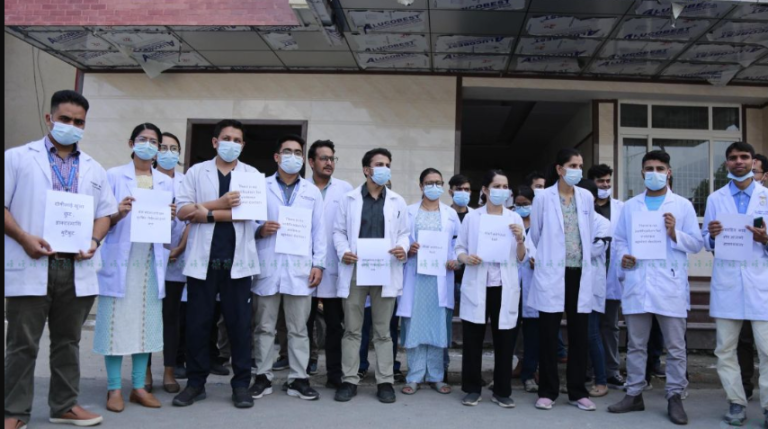The Nepal Medical Association (NMA) has stopped all non-emergency medical services across the country starting Friday, April 25. The strike affects both private and public hospitals, medical colleges, and clinics. Only emergency and intensive care services will continue. The NMA says this protest supports resident doctors studying MD and MS in private colleges. These doctors are asking for the same allowance as those in government-owned colleges. The decision is already backed by the government, but private colleges have refused to follow it.
Why are doctors protesting
The protest began after many resident doctors reported unfair treatment by private medical colleges. These doctors work long hours in hospitals while studying for their postgraduate degrees. But unlike their peers in government colleges, they receive much lower pay or none at all.
The Medical Education Commission, led by Prime Minister KP Sharma Oli, decided earlier this year that allowances should be equal for all postgraduate medical students, no matter where they study. However, private colleges say they cannot increase the pay and claim the law does not force them to follow the commission’s decision.
Demonstrations in Kathmandu
On Thursday, April 24, doctors held a protest in Maitighar, Kathmandu. They formed a human chain around the district administration offices. The protest was peaceful but made a strong statement.
The demonstration was led by the Nepal Doctors’ Association, which is closely working with the Nepal Medical Association on the issue.
Strong message from the NMA
Dr Shesh Raj Ghimire, who is the coordinator of the Safe Workplace Struggle Committee for Health Workers, said the labour exploitation of resident doctors must stop. He also said that private medical colleges are not respecting the rights of resident doctors. This is not just about money. This is about dignity and fair treatment.
Government response
Health Minister Pradip Paudel met with NMA officials and the protesting doctors. According to The Kathmandu Post, Minister Paudel promised that the government supports the decision made by the Medical Education Commission. He said that the demands of the resident doctors are fair.
But the President of the Nepal Medical Association, Anil Bikram Karki, said words are not enough. He said doctors need actual allowances, not just promises.
How the strike affects patients
This strike will affect thousands of people who need medical care. Only emergency services will run. People with regular medical appointments, follow-up visits, or non-urgent treatments will have to wait.
Hospitals have already started turning away patients for non-urgent care. Many families in rural areas are especially worried, as access to healthcare is already limited outside major cities.
What happens next
Unless private colleges agree to follow the government’s decision soon, the strike may continue. The NMA says it will keep pushing until resident doctors are treated fairly.
There are also talks about further protests if no solution is found. The NMA has called on the public to understand their cause. They say that fair treatment of doctors is important for the future of Nepal’s healthcare system.
Background of the conflict
In February 2025, resident doctors had already gone on strike over the same issue. That strike led to the 16th meeting of the Medical Education Commission, which confirmed that allowances should be the same for all medical students. The decision was expected to solve the issue, but implementation has failed.
Private colleges argue that they do not have enough funds to offer equal allowances. But critics say that many of these colleges charge high fees and should be able to support their doctors.
This ongoing conflict shows a deeper problem in Nepal’s healthcare education system. While the government seems willing to help, private colleges are not following through. Until this changes, strikes like this may happen again.
The Nepal Medical Association is urging the government to take stronger action. As of now, only emergency services will continue, and the health of many patients remains at risk.


